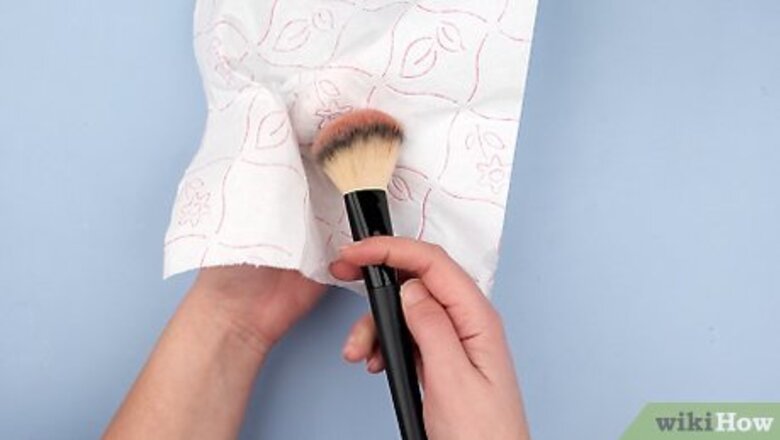
views
Wipe off excess makeup.
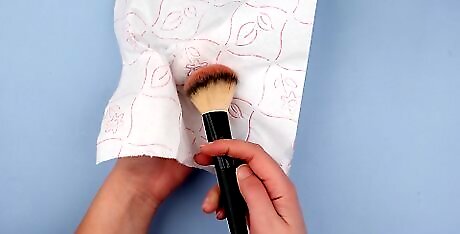
Remove any chunky makeup to make the cleaning process easier. Before you start deep cleaning, grab a paper towel or a clean hand towel and give your brush a good wipe-down (handle and all). Just one quick wipe can take off a lot of product and makes the cleaning job that much easier. Try swirling your makeup brush on a paper towel a couple of times or use a makeup brush cleaning mat to clear away stubborn product.
Run the bristles under warm water.
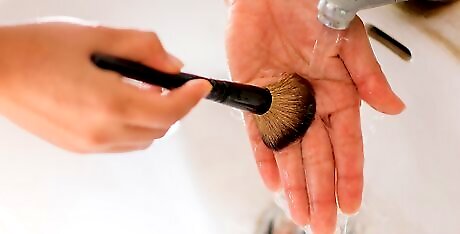
Place the brush under water and keep the bristles pointed downward. This will help prevent water from running back into the center of the brush, which can dissolve the glue that holds the bristles together and ruin your brush. Move and separate the bristles to clean the inside of the brush. Stick to lukewarm water, not hot. Hot water can damage the bristles on your brush over time, especially if you clean them often. Try using a makeup brush cleaning mat during this step, too, if you’re brushes are exceptionally dirty.
Mix warm water and shampoo.
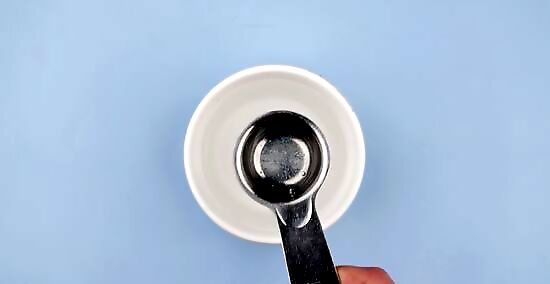
Make a cleaning solution with a baby or clarifying shampoo. Fill up a bowl or a shallow dish with water, then mix in your shampoo of choice. The measurements don’t have to be exact, but try sticking to a 1:2 ratio (1 part shampoo and 2 parts water). As long as there’s enough water to cover the bristles of your brush, your good to go. Alternatively, use a makeup cleanser or brush detergent instead if you have one on hand. While some makeup experts recommend using dish soap to cleanse your brushes because of its degreasing properties, others warn that the harsh soap could dry your bristles out over time.
Add olive oil or coconut oil.
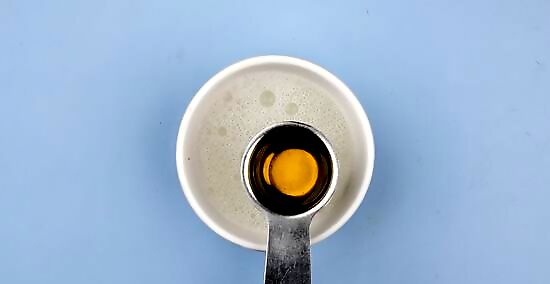
Put oil in your DIY cleaner if you use oil-based products. Oil-based foundations and concealers can be harder to get off your makeup brushes; however, adding a 1 US tbsp (15 mL) of olive or coconut oil can help break down the product and clean your brushes. Consider adding oil if you use natural brushes, as the natural oils can help keep the organic bristles in tip-top shape.
Swirl the brushes in your mixture.
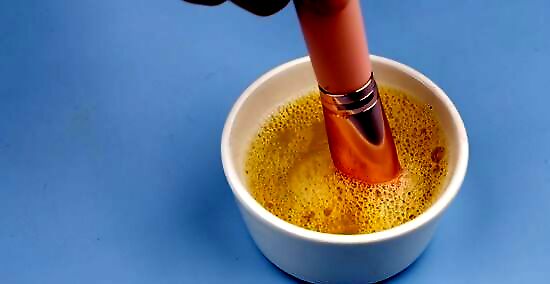
Dip your brushes into the DIY cleaner and lather them up. Carefully swirl the bristles around in the cleaner until bubbles start to form. Do this for about 20 seconds. The mixture will get cloudy or dirty as you clean your brushes—this is a good sign! The makeup is coming off of your brushes. If your brush is very dirty, swirl it around in the palm of your hand or on a makeup brush cleaning mat to work up a lather. This helps agitate the bristles more and provides a deeper clean.
Rinse the brush.
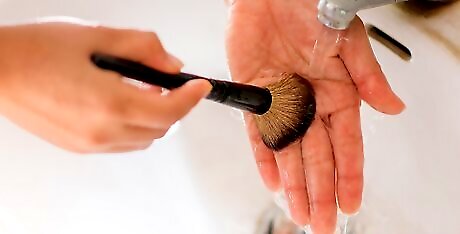
Continue massaging the bristles to really clean them. Keep the brush pointed downwards so the water doesn’t run back into the handle, and rinse until all of the soap or shampoo is completely gone. Don’t worry if your brush isn’t completely clean yet—there’s still another chance to cleanse it further. If the water runs completely clean, your brush is good to go! Skip the next step and go straight to the drying process.
Shampoo the brush again.
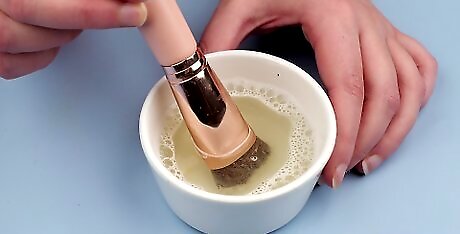
Thick makeup might be tricky to get out and may require 2 cleanses. If your brush needs it, empty the dirty bowl of DIY cleanser and fill it back up as you did before with water, shampoo, and possibly oil. Swirl the brush around again, then rinse it using warm water. For most brushes, cleaning it a second time will be enough for a thorough cleansing. But if your brush isn’t completely clean after a second shampoo, keep washing it until the water runs clear.
Squeeze out excess water.
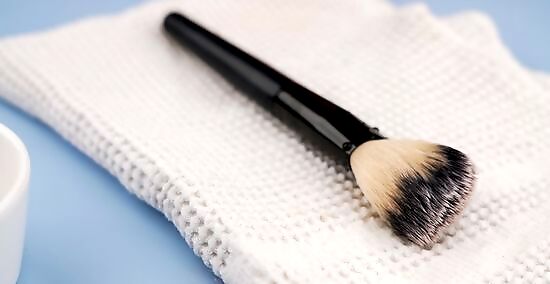
Make sure your brushes aren't dripping wet before drying them. Use your hands or a clean paper towel to gently squeeze the bristles until damp. Don’t wring or rub the brushes, as forceful motions could damage the bristles. To remove even more water, shake the bristles out over the sink with quick flicking motions. Avoid tilting the brushes upwards while they’re wet so water doesn't run into the handle.
Lay your brushes out to dry.
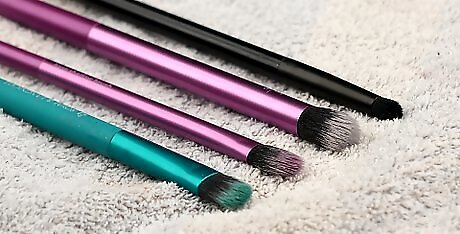
Put a clean towel down to catch any extra moisture from the brushes. Hang the tip of your washed brush off the edge of a counter or table. This way, the bristles will air dry normally and not flatten out. Try to keep the brushes lying down until they’re fully dry to prevent any water damage; otherwise, the glue connecting the brush and handle may loosen. Depending on the size and thickness of your brushes, they could take a few hours or a full day to dry. Although it might seem like a good idea, don’t use heat to dry your brushes! Hair dryers can damage and warp the bristles, especially if they’re synthetic.
Spray brushes with rubbing alcohol after use.
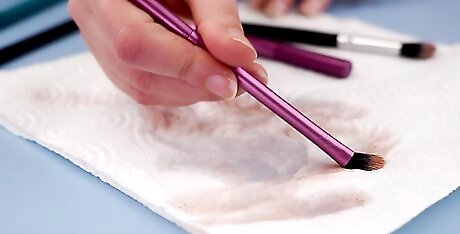
Sanitize makeup brushes daily to keep them germ- and bacteria-free. After you use any of your brushes, spritz a bit of rubbing alcohol onto the bristles, then gently wipe the brush on a clean cloth. Leave the brush out to dry before you use it again. Pour some rubbing alcohol into a miniature spray bottle to store with your other makeup products so you never forget to cleanse your brushes. If you’re worried about germs on your makeup brushes, consider investing in a makeup brush sterilizer. These machines use UV light to disinfect makeup brushes in minutes, leaving them 99.9% germ-free.
Deep clean makeup brushes once a week.
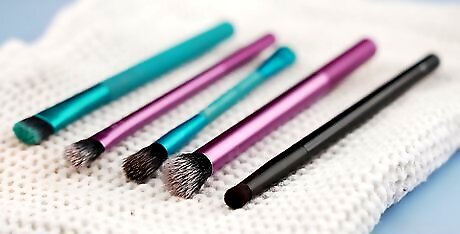
Using dirty makeup brushes can lead to clogged pores and breakouts. If you use your brushes often, aim to clean them thoroughly every 7 to 10 days. This way, you can enjoy wearing makeup without worrying about breakouts or bacterial infections. Along with this, aim to clean your brushes whenever you apply different colored products to prevent discoloration in your makeup look. For instance, if you did a bold smokey eye for a fun night out, clean your brushes before putting on pink eyeshadow; otherwise, your subtle pink look will be smeared with black shadow. Brushes used to apply foundation and concealer are the most prone to bacteria, as they’re used all over the face and are coated in the most product. If you use a beauty blender or sponge to apply your makeup, experts recommend cleaning the blender sponge weekly as well.

















Comments
0 comment